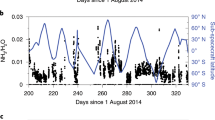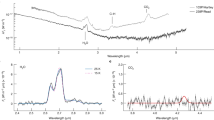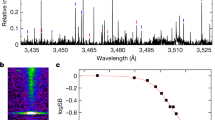Abstract
Recent mass spectrometer measurements of the composition of the coma of Giacombini-Zinner and Halley comets have indicated the presence of large amounts of H3O+. Here, we suggest that some of these ions arise from the photoionization of the water dimer, which is formed by direct vaporization of ice from solid surfaces at the cometary nucleus or from ice particles ejected in cometary jets.
This is a preview of subscription content, access via your institution
Access options
Subscribe to this journal
Receive 51 print issues and online access
$199.00 per year
only $3.90 per issue
Buy this article
- Purchase on Springer Link
- Instant access to full article PDF
Prices may be subject to local taxes which are calculated during checkout
Similar content being viewed by others
References
Ogilvie, K. W., Coplan, M. A., Bochsler, P. & Geiss, J., Science 232, 374–377 (1986).
Coplan, M. A., Ogilvie, K. W., A'Hearn, M. F., Bochsler, P. & Geiss, J. J. geophys. Res. 92, 39–46 (1987).
Balsiger, H. et al. Nature 321, 330–334 (1986).
Krankowsky, D. et al. Nature 321, 326–329 (1986).
Huebner, W. F. & Giguere, P. T. Astrophys. J. 238, 753–762 (1980).
Huebner, W. F. in The Photochemistry of Atmospheres 437–481 (Academic, New York 1985).
Albritton, D. L. At. Data nucl. Tabl. 22, 1–101 (1978).
Lishawa, C. R., Salter, R. H. & Murad, E. J. chem. Phys. (in the press).
Curtiss, L. A., Frurip, D. J. & Blander, M. J. chem. Phys. 71, 2703–2711 (1979).
Slanina, Z. Chem. Phys. Lett. 127, 67–72 (1986).
Keller, H. U. et al. Nature 321, 320–326 (1986).
Ng, C. Y. et al. J. chem. Phys. 67, 4235–4237 (1977).
Good, A., Durden, D. A. & Kebarle, P. J. chem. Phys. 52, 222–229 (1970).
Coplan, M. A., Ogilvie, K. W. & A'Hearn, M. F. Pap. presented at 20th ESLAB Symposium Exploration of Halley's Comet, Heidelberg, 27–31 October 1986.
Eberhardt, P. et al. Pap. presented at 20th ESLAB Symposium Exploration of Halley's Comet, Heidelberg, 27–31 October 1986.
Wallis, M. K., Rabilizirov & Wickramasinghe, N. C. Pap. presented at 20th ESLAB Symposium Exploration of Halley's Comet, Heidelberg, 27–31 October 1986.
Gombosi, T. I., Nagy, A. F. & Cravens, T. E. Rev. Geophys. 24, 667–700 (1986).
Christophorou, L. G., McCorkle, D. L. & Christodoulides, A. A. in Electron Molecule Interactions and Their Applications Vol. 1 (ed. Christophorou, L. G.) 477–619 (Academic, New York, 1984).
Huntress, W. T., Kim, J. K. & Theard, L. P. Chem. Phys. Lett. 29, 189–190 (1974).
Author information
Authors and Affiliations
Rights and permissions
About this article
Cite this article
Murad, E., Bochsler, P. Speculations about the origin of H3O+ seen in cometary mass spectra. Nature 326, 366–367 (1987). https://doi.org/10.1038/326366a0
Received:
Accepted:
Issue Date:
DOI: https://doi.org/10.1038/326366a0
This article is cited by
-
A refined evaluation of the gas-phase water-dimerization equilibrium constant within non-rigid BJH- and MCY-type potentials
International Journal of Thermophysics (1992)
-
Probable detection of organic-dust-borne aromatic C3H3+ ions in the coma of comet Halley
Nature (1989)
Comments
By submitting a comment you agree to abide by our Terms and Community Guidelines. If you find something abusive or that does not comply with our terms or guidelines please flag it as inappropriate.



